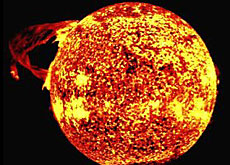Sunspot activity hits 1,000-year high

The Sun is burning brighter than at any time over the past 1,150 years, according to a study by a professor at a Swiss university.
Professor Sami Solanki said this could be compounding the effects of greenhouse gases and contributing to global warming.
“We have to acknowledge that the Sun is in a changed state. It is brighter than it was a few hundred years ago, and this brightening started relatively recently – in the last 100 to 150 years. We expect it to have an impact on global warming,” he told swissinfo.
Last week Solanki, who is a professor at the Federal Institute of Technology in Zurich, presented the findings at a conference of solar and stellar scientists in Hamburg, Germany.
His research team reached its conclusions after studying data from samples of ice collected by Swiss scientist Jürg Beer on an expedition to Greenland in 1991.
Most scientists acknowledge that greenhouse gases from fossil fuels have warmed the planet in past decades, but they have questioned whether a brighter Sun is also responsible for rising temperatures.
Global warming
Average global temperatures have increased by about 0.2 degrees Celsius over the past 20 years, and are widely believed to be responsible for new extremes in weather patterns across the world.
According to scientists, the Sun’s radiance has changed little during this period. But looking back over 1,150 years, Solanki found the Sun had never been as bright as in the past 60 years.
The indirect impact of more intense sunshine on the ozone layer and of solar activity on cloud cover may be affecting the climate more than the sunlight itself, he said.
“The change in solar brightness over the past 20 years is not enough to cause the observed changes in our climate. But the indirect effects may be larger, and the range of their influence is unclear, so more study is needed,” he added.
Sunspots
To see whether a brighter Sun is warming the planet, solar scientists have measured magnetic zones on the Sun’s surface, called sunspots.
Sunspots appear to intensify the Sun’s brightness and energy output, and their numbers are associated with climate, said Solanki, who is also managing director of the Max Planck Institute for Solar System Research in Germany.
Looking back over several hundred years, Solanki’s team found that not only did a dearth of sunspots signal a cold period – sometimes for as long as 50 years – but they also discovered that the number of sunspots increased over the past century as the Earth’s climate grew steadily warmer.
“All in all, I think we are coming to a point where we acknowledge that both solar activity and greenhouse gases are important factors in the change in the Earth’s temperature,” he said.
swissinfo, Elizabeth Meen
To find out if a brighter Sun is worsening the trend to global warming, scientists studied ice collected from Greenland.
To determine the influence of solar activity, they measured beryllium, a substance that appears when the Sun’s energy is at high points.

In compliance with the JTI standards
More: SWI swissinfo.ch certified by the Journalism Trust Initiative




You can find an overview of ongoing debates with our journalists here. Please join us!
If you want to start a conversation about a topic raised in this article or want to report factual errors, email us at english@swissinfo.ch.